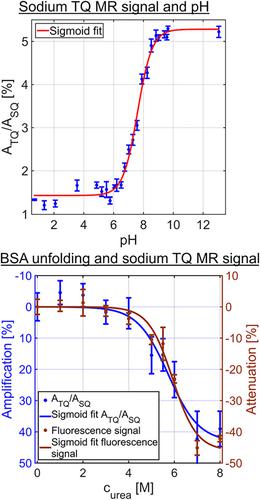当前位置:
X-MOL 学术
›
NMR Biomed.
›
论文详情
Our official English website, www.x-mol.net, welcomes your
feedback! (Note: you will need to create a separate account there.)
Protein conformational changes affect the sodium triple-quantum MR signal.
NMR in Biomedicine ( IF 2.7 ) Pub Date : 2020-07-12 , DOI: 10.1002/nbm.4367 Dennis Kleimaier 1 , Victor Schepkin 2 , Ruomin Hu 1 , Lothar R Schad 1
NMR in Biomedicine ( IF 2.7 ) Pub Date : 2020-07-12 , DOI: 10.1002/nbm.4367 Dennis Kleimaier 1 , Victor Schepkin 2 , Ruomin Hu 1 , Lothar R Schad 1
Affiliation

|
The aim of this study was to investigate possible sodium triple‐quantum (TQ) signal dependence on pH variation and protein unfolding which may happen in vivo. The model system, composed of bovine serum albumin (BSA), was investigated over a wide pH range of 0.70 to 13.05 and during urea‐induced unfolding. In both experimental series, the sodium and BSA concentration were kept constant so that TQ signal changes solely arose from an environmental change. The experiments were performed using unique potential to detect weak TQ signals by implementing a TQ time proportional phase increment pulse sequence. At a pH of 0.70, in which case the effect of the negatively charged groups was minimized, the minimum TQ percentage relative to single‐quantum of 1.34% ± 0.05% was found. An increase of the pH up to 13.05 resulted in an increase of the sodium TQ signal by 225%. Urea‐induced unfolding of BSA, without changes in pH, led to a smaller increase in the sodium TQ signal of up to 40%. The state of BSA unfolding was verified by fluorescence microscopy. Results of both experiments were well fitted by sigmoid functions. Both TQ signal increases were in agreement with an increase of the availability of negatively charged groups. The results point to vital contributions of the biochemical environment to the TQ MR signals. The sodium TQ signal in vivo could be a valuable biomarker of cell viability, and therefore possible effects of pH and protein unfolding need to be considered for a proper interpretation of changes in sodium TQ signals.
中文翻译:

蛋白质构象变化影响钠三量子 MR 信号。
本研究的目的是研究可能发生的钠三量子 (TQ) 信号对 pH 变化和蛋白质解折叠的依赖性,这可能在体内发生。该模型系统由牛血清白蛋白 (BSA) 组成,在 0.70 至 13.05 的宽 pH 范围内和尿素诱导的解折叠过程中进行了研究。在这两个实验系列中,钠和 BSA 的浓度保持恒定,因此 TQ 信号的变化仅由环境变化引起。通过实施 TQ 时间成比例的相位增量脉冲序列,使用独特的电位来检测弱 TQ 信号进行实验。在 pH 值为 0.70 的情况下,带负电荷基团的影响最小,相对于单量子的最小 TQ 百分比为 1.34% ± 0.05%。pH 值增加到 13.05 会导致钠 TQ 信号增加 225%。尿素诱导的 BSA 解折叠,pH 没有变化,导致钠 TQ 信号的增加幅度较小,最高可达 40%。BSA 解折叠的状态通过荧光显微镜验证。两个实验的结果都很好地拟合了 sigmoid 函数。两种 TQ 信号的增加都与带负电荷基团的可用性增加一致。结果表明生化环境对 TQ MR 信号的重要贡献。钠 TQ 信号体内可能是细胞活力的有价值的生物标志物,因此需要考虑 pH 和蛋白质解折叠的可能影响,以正确解释钠 TQ 信号的变化。
更新日期:2020-09-03
中文翻译:

蛋白质构象变化影响钠三量子 MR 信号。
本研究的目的是研究可能发生的钠三量子 (TQ) 信号对 pH 变化和蛋白质解折叠的依赖性,这可能在体内发生。该模型系统由牛血清白蛋白 (BSA) 组成,在 0.70 至 13.05 的宽 pH 范围内和尿素诱导的解折叠过程中进行了研究。在这两个实验系列中,钠和 BSA 的浓度保持恒定,因此 TQ 信号的变化仅由环境变化引起。通过实施 TQ 时间成比例的相位增量脉冲序列,使用独特的电位来检测弱 TQ 信号进行实验。在 pH 值为 0.70 的情况下,带负电荷基团的影响最小,相对于单量子的最小 TQ 百分比为 1.34% ± 0.05%。pH 值增加到 13.05 会导致钠 TQ 信号增加 225%。尿素诱导的 BSA 解折叠,pH 没有变化,导致钠 TQ 信号的增加幅度较小,最高可达 40%。BSA 解折叠的状态通过荧光显微镜验证。两个实验的结果都很好地拟合了 sigmoid 函数。两种 TQ 信号的增加都与带负电荷基团的可用性增加一致。结果表明生化环境对 TQ MR 信号的重要贡献。钠 TQ 信号体内可能是细胞活力的有价值的生物标志物,因此需要考虑 pH 和蛋白质解折叠的可能影响,以正确解释钠 TQ 信号的变化。











































 京公网安备 11010802027423号
京公网安备 11010802027423号